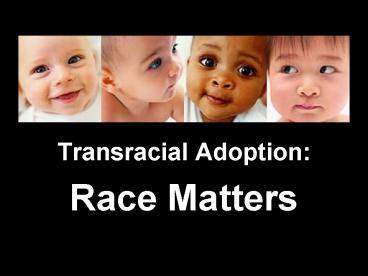Transracial Adoption: - PowerPoint PPT Presentation
1 / 17
Title:
Transracial Adoption:
Description:
... white homes are cut off from the healthy development of themselves as black people...We ... diverse and minority adoptive families to meet children needs ... – PowerPoint PPT presentation
Number of Views:1304
Avg rating:3.0/5.0
Title: Transracial Adoption:
1
- Transracial Adoption
- Race Matters
2
What Is Transracial Adoption?
- Transracial adoption (TRA) means placing a child
who is of one race or ethnic group with adoptive
parents of another race or ethnic group. - In the United States, this term usually refers
to the placement of children of color or children
from another country with Caucasian adoptive
parents.
3
Hot Topic of Debate
- Supporters
- believed that spending more time in out-of-home
care was more detrimental to the child when
compared to the alleged harm the child will
suffer from a transracial placement. - Opponents
- argue that adoptive parents can not adequately
prepare their children of color for the racial
realities they are bound to encounter outside
their homes of one race or ethnic group with
adoptive parents of another race or ethnic group.
4
The Problem
- Disproportional minority representation in the
child welfare system has been a major concern for
decades. - Research suggests an apparent disparity in the
proportion of Caucasian children and children of
color in the system.
5
A Possible Solution
- Most commonly cited factors for
overrepresentation are related to - Poverty
- Isolation
- Substance abuse
- Child abuse
- Racial discrimination
- While these socioeconomic factors play a role in
the overrepresentation, differential treatment
and services provided by the child welfare system
also contribute to the problem. Children of
color have limited access to the services offered
by the system. When compared to Caucasian
children, minority children spend more time in
out-of-home care and tend to have a less likely
chance of achieving permanency. Recognizing the
improvements needed to reduce the
disproportionate number of minority children in
the child welfare system, transracial adoptions
emerged as a possible solution.
6
Race Matching
- Placing Children with Same Race Families
Prior to the rise in transracial adoptions, the
matching of children with potential adoptive
parents occurred largely on the basis of
race. The principle goal of race matching was
to create families in which adoptive parents
looked as though they could be the adopted
childs biological parents.
7
Developing Trends
NABSW
- 1950s
- Post WWII Japanese and Chinese
- Post Korean War Koreans
- 1960s
- African Americans
8
In 1972, the National Association of Black Social
Workers (NABSW) issued a position paper, which
essentially condemned the adoption of black
children by white families. Black children in
white homes are cut off from the healthy
development of themselves as black peopleWe have
committed ourselves to go back to our communities
and work to end this particular form of
genocide. NABSW explained that transracial
placements prevent black children from forming a
strong racial identity and prevent them from
developing survival skills necessary to deal with
a racist society. As a result, adoption
agencies nationwide used the position paper as a
justification for implementing or continuing
race-matching practice.
9
10
Supply Demand
CAUCASIAN
MINORITY
AVAILABLE PARENTS
AVAILABLE CHILDREN
AVAILABLE PARENTS
AVAILABLE CHILDREN
11
MULTIETHNIC PLACEMENT ACTOF 1994 (MEPA)
- 3 Main Purposes
- Decrease length of time children waited to be
adopted - Prevent discrimination based on race, color
and/or national origin when making foster care
and adoptive placements - Facilitate identification and Recruitment of
culturally diverse and minority adoptive families
to meet children needs
12
(No Transcript)
13
Removal of Barriers to Interethnic Adoption of
1996 (IEP)
- Repealed MEPA
- Deleted Permissible Consideration
- Removed language from MEPA
- A person or government that is involved in
adoption or foster care placements may not(a)
categorically deny to any individual the
opportunity to become an adoptive or a foster
parent, solely on the basis of race, color, or
national origin of the individual, or the child
involved or (b) delay or deny the placement of a
child for adoption or into foster care or
otherwise discriminate in making a placement
decision, solely on the basis of race, color, or
national origin of the adoptive or foster parent,
or the child, involved.
14
Common Goal
- Noticing the lack of better alternatives,
opponents began to gradually accept the practice
itself, though still questioning the ability of
effectively parenting a transracial adoptee. - While debates continue regarding the importance
of race in America, both sides agree that their
primary goal is the best interests of the child
15
Best Interests of a Transracial Adoptee
- Despite the controversial fluctuation of
transracial adoptions, the practice continues.
Recognizing conflicting attitudes is a start
towards the success of transracial adoptions. - However, since the widespread acceptance alone is
not the solution to achieving the best interests
of a child, extensive studies should be conducted
to determine to what extent the law can interfere
with parenting a transracial adoptee. The lack
of effective parenting, not the actual
transracial adoption, is what compromises the
best interests of a child.
16
(No Transcript)
17
- Transracial
- Adoption
- The End































